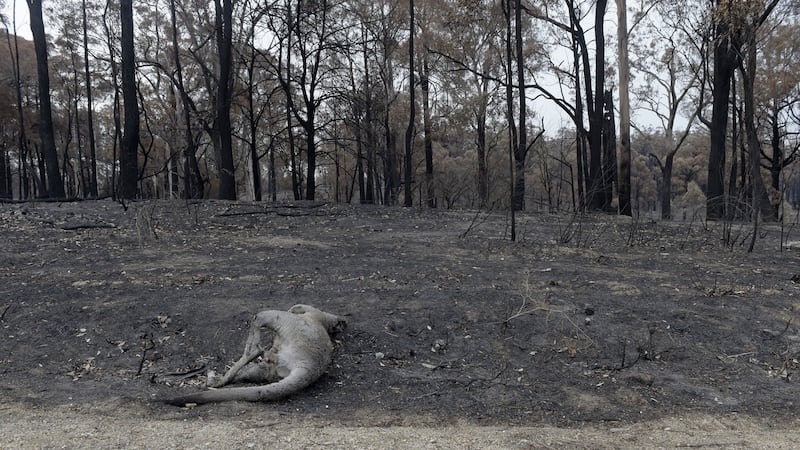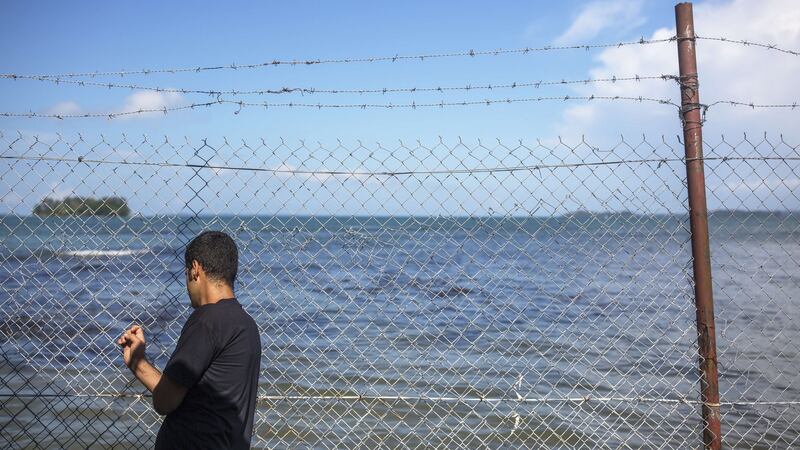Not so long ago, one of the reigning cliches around the subject of climate crisis was that it was a “looming catastrophe”. The situation was urgent, yes, and catastrophe was more or less imminent, but when people talked about it they mostly stuck to the future tense.
It’s hard to identify the precise moment when the crisis moved from the horizon of popular imagination to the immediate foreground, but the spectacle in recent weeks of a continent in flames feels like a clear indication that the time of looming has ended and the catastrophe proper has commenced.
The other day I messaged an Australian friend, a volunteer firefighter in Melbourne who had spent the week between Christmas and new year in East Gippsland, where thousands of people have been evacuated from their homes. After informing me she was home and safe, and requesting that I arrange for some Irish rain to be redirected down there, she sent me a photo she had taken on the job: an image of a narrow dusty road leading toward low hills dotted with trees, behind which the sky itself was a vast inferno of dark smoke and glowing flame. I stared at her photo for a long time, and kept returning to it all that day.


There was something both bizarre and instructive about the image, the way in which the gentle bucolic scene in the foreground was juxtaposed surreally against the literally hellish sky behind it. It made me think of René Magritte’s Empire of Light series of paintings, in which scenes of a residential street at night are presided over by a bright, daylit sky.
It also made me think of what life is basically like now: a calm foreground with an inferno on the horizon. And it struck me that this would be a thing that would happen at the end of the world. People would point their phones at the fire in the sky, and they would send photos to their friends in other places. “This is what the apocalypse looks like here,” they would say. “How is it where you are?” There would be a great storm of content and engagement, and then there would be nothing at all.
One thing that is often remarked about climate crisis is that the subject is characterised by a strange form of cognitive dissonance. You read about the melting ice caps, the rising temperatures, the mass extinctions, and you understand intellectually that something truly terrible is happening. It doesn’t feel like that on the nerve endings, though. On the nerve endings, it feels like an unseasonably warm day in January. But what is happening in Australia, and the images that are emerging from the fires, feels like a closing of the gap between the scientific evidence and the field of immediate perception.
A little boy in a facemask in a small boat at sea, his hand on the outboard tiller, the sky behind him an incandescent haze. Two horses in silhouette against a burning forest. Crowds of masked people taking refuge on a beach. That same beach littered with the corpses of tropical birds. A kangaroo burned alive, trapped by a barbed wire fence. All these scenes suffused with a malignant red glow, as though put through an Instagram filter named “Inferno”. It looks like a film. It looks like a video game. It looks like what we have always imagined the end of the world would look like.


In East Gippsland, where my friend had been dispatched to fight the fires after Christmas, the situation was so severe that the government issued an emergency warning telling the remaining residents that it was too late to evacuate. “You are in danger,” read the warning, “and need to act immediately to survive.”
Here on the other side of the world, thousands of miles from the immediate peril of the fires, it’s impossible not to read this as a warning about the broader climate emergency. It’s the message we’ve been hearing from scientists and activists for decades.
And it is undoubtedly the message of those apocalyptic images from Australia, bathed in the crimson radiance of catastrophe. If God himself were to materialise and deliver this message, it could not be any clearer, any more urgent. You may recall, in fact, that it was by means of a burning bush that God announced it was time to lead the Israelites out of Egypt.
Yet the most disturbing thing about the images of the fires is not that they might signal the end of the world, but that they might signal how the world will continue. That we might just get used to large parts of the planet being on fire, and even larger parts of it being underwater. And more disturbing still, that we might harden our hearts against the people who live and die in the floods and the fires.

Because when I look at the images of those Australians crowded on the beaches, fleeing the smoke and the flames, there is a kind of double exposure effect, whereby I see the ghostly image of those other refugees who have come by boat to Australia from places where they were no longer safe, only to be held indefinitely and in appalling conditions on offshore detention facilities in the South Pacific. In the rest of the world, their suffering has been mostly ignored. These people know better than anyone what an apocalypse looks like.
It's not the melting of the ice-caps or the burning of the forests that seem to me to be the real apocalyptic scenario, but rather the slow atrophying of our moral imaginations; not the inferno itself, but the indifference of those of us who are not yet on fire. In this sense above all we are in danger, and we need to act immediately to survive. – Guardian
Mark O'Connell is a writer based in Dublin. He is the author of To Be a Machine, which was awarded the 2019 Rooney Prize for Irish Literature, the 2018 Wellcome Book Prize and was shortlisted for the Baillie Gifford Prize for Non-Fiction. His book Notes from an Apocalypse will be published in April.



















